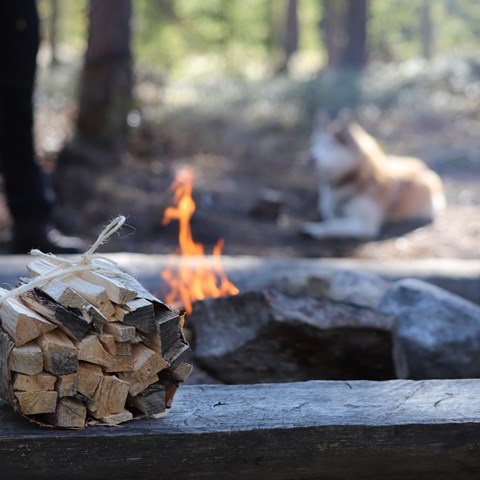Recreation and wellness

Wellness is about living healthily, eating right, getting enough sleep and being physically active, preferably outdoors. Much of the research that exists about wellness in outdoor environments relates to forest bathing in Asia. This is dealt with in another section and is therefore not covered here.
One British study has compiled a number of British research projects in which people have participated in activities in tree and forest environments (O'Brien & Morris 2014). It refers to physical, social, cultural and nature-based activities, and also courses in mental well-being. It asserts that the benefits of being in the forest can be that we feel close to nature, 'have a feeling for nature', experience both mental and physical well-being, that we learn things and get a feeling of social inclusion.
When university students in Ireland were encouraged to walk on campus and outside in nature, it turned out that the latter was perceived as more energetic and revitalising and was more cognitively enhancing than walking in the city (Shrestha et al. 2021). Young Polish people felt mentally better and had lower blood pressure and pulse rates after recreation in a nature reserve (Bielinis et al. 2019).
Another study compiled research projects dealing with outdoor recreation and its effect on mental health (Lackey et al 2019). The researchers were able to show that outdoor activities increased well-being, cognition and recovery and decreased anxiety, depression and stress.
Long hikes have also been the subject of research. In this case, it was shown that this relatively tough activity has a positive effect on mental health and seems to be the optimum way to allay anxiety when we are having "internal struggles" (Mau et al. 2021). For those who want to achieve well-being and enjoyment, long hikes are not so effective.
One study from Norway suggests that families with young children who go hiking in the Norwegian way, experience a sense of the here-and-now, and feel that they have more time to socialise than usual (Baklien 2015). In everyday life, they have a lot of interaction with people outside the family unit, so the hike brings the family closer together. Although nature is not the most important aspect of the hikes, it seems to act as a peaceful background to social relationships. Parents also feel that hiking gives them the opportunity to communicate knowledge to their children.
Recreation in the urban forest and in nature reserves and green zones in the city increased significantly in the Nordic countries during the Covid pandemic (e.g., Fagerholm et al. 2021, Venter et al. 2021). This was because people found it easier to get outdoors when they worked from home and because they chose to be in the forest to maintain social distancing. In the United States, however, the outdoor life of people accustomed to being in nature decreased and they also travelled less than before to participate in creative activities (Rice et al. 2021). This decrease was due to travel restrictions and probably to the fact that, during the pandemic, they chose to avoid the group activities they had previously taken part in. Young American people reduced their outdoor activities during the pandemic, the result being worse mental health (Jackson et al. 2021).
/Text: Ann Dolling
References
Børge Baklien, Borgunn Ytterhus & Rob Bongaardt (2016) When everyday life becomes a storm on the horizon: families’ experiences of good mental health while hiking in nature, Anthropology & Medicine, 23:1, 42-53, https://doi.org/10.1080/13648470.2015.1056056
Ernest Bielinis, Lidia Bielinis, Sylwia Krupinska-Szeluga, Adrian Łukowski and Norimasa Takayama (2019) The Effects of a Short Forest Recreation Program on Physiological and Psychological Relaxation in Young Polis h Adults. Forests 10;34. http://dx.doi.org/10.3390/f10010034
Nora Fagerholm , Salla Eilola, Vesa Arki (2021) Outdoor recreation and nature’s contribution to well-being in a pandemicsituation - Case Turku, Finland. Urban Forestry & Urban Greening, 64 https://doi.org/10.1016/j.ufug.2021.127257
Jackson S.B, Stevenson K.T, Larson L.R, Peterson M.N, Seekamp E. (2021) Outdoor Activity Participation Improves Adolescents’Mental Health and Well-Being during he COVID-19 Pandemic. Int. J. Environ. Res. Public Health 2021, 18,2506. https://doi.org/10.3390/ijerph18052506
Mau, M.; Aaby, A.;Klausen, S.H.; Roessler, K.K. Are (2021) Long-Distance Walks Therapeutic? A Systematic Scoping Review of the Conceptualization of Long-Distance Walking and Its Relation to Mental Health. Int. J. Environ. Res. Public Health 2021, 18, 7741. https://doi.org/10.3390/ijerph18157741
Nancy Qwynne Lackey, Deborah A. Tysor, G. David McNay, Leah Joyner, Kensey H. Baker & Camilla Hodge (2021) Mental health benefits of naturebased recreation: a systematic review, Annals of Leisure Research, 24:3, 379-393, https://doi.org/10.1080/11745398.2019.1655459
Liz O'Brien & Jake Morris (2014) Well-being for all? The social distribution of benefits gained from woodlands and forests in Britain, Local Environment, 19:4, 356-383, https://doi.org/10.1080/13549839.2013.790354
WL Rice, TJ Mateer, N Reigner, P Newman, B Lawhon and BD Taff (2020) Changes in recreational behaviors of outdoor enthusiasts during the COVID-19 pandemic: analysis across urban and rural communities. Journal of Urban Ecology, 2020, 1–7. https://doi.org/10.1093/jue/juaa020
Shrestha, T.; Di Blasi, Z.;Cassarino, M. (2021) Natural or Urban Campus Walks and Vitality in University Students: Exploratory Qualitative Findings from a Pilot Randomised Controlled Study. Int. J. Environ. Res. Public Health, 18,2003. https://doi.org/10.3390/ijerph18042003
Venter, ZS, Barton DN, Gundersen V, Figari H, Nowell M. (2021) Back to nature: Norwegians sustain increased recreational use of urban green space months after the COVID-19 outbreak. Landscape & Urban Planning 214. https://doi.org/10.1016/j.landurbplan.2021.104175